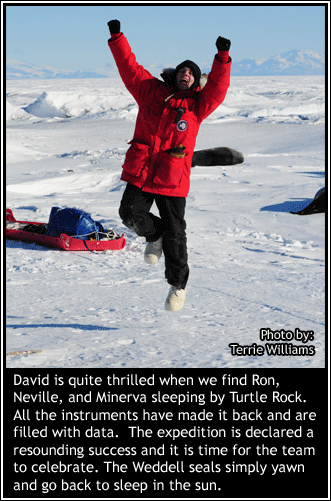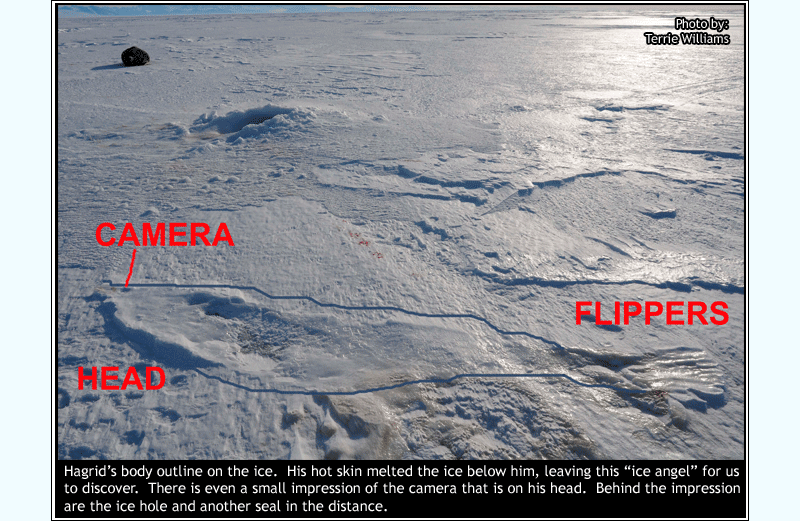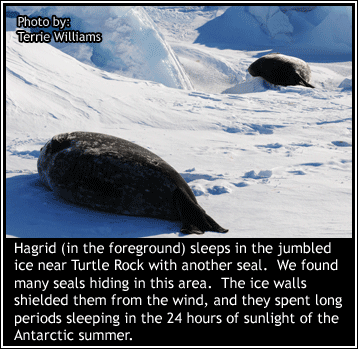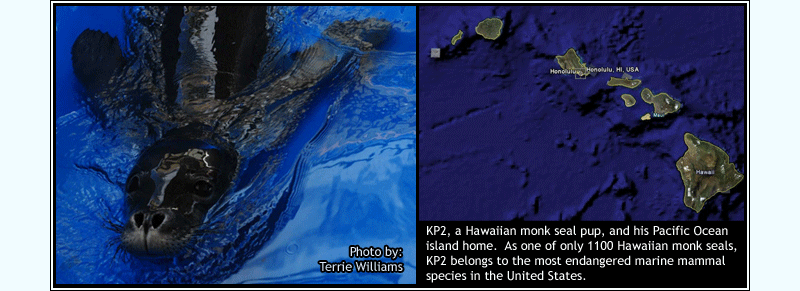|
|
Vince’s Cross on Hut Point overlooking McMurdo Station commemorates George T. Vince,
who drowned near this spot March 11, 1902 during Scott’s “Discovery” expedition. |
| |
 |
WILD ANTARCTICA
Antarctica is a beautiful, dangerous place. Each day we are reminded of the dangers associated with living and working in such a harsh environment by the number of monuments to lives lost exploring this continent. Frostbite, snow blindness, dehydration, and falling through the ice or into crevasses are constant threats. Small mistakes can be lethal, and we have to be careful not to become too confident as we travel on the sea ice looking for our seals. Even the renowned Antarctic explorer Robert Falcon Scott was lost on the ice nearly 100 years ago, close to where we are working today.
One day we pass one of Scott’s huts while we are looking for Professor McGonaSeal, Ron WeSealey, Neville, and Hagrid the Seal. It is a small, grey, weathered wooden building all alone on black volcanic rubble. Everything inside has been frozen in time since Scott’s 1911 Terra Nova expedition. It is apparent that the brave members of the expedition had prepared for the cold. The building insulation was provided by a seaweed quilt placed in the walls and roof. Sleeping bags made of deer hides and rough military-style wool blankets are still snuggled close to an old stove. |
 |
| |
|
|
|
| |
|
|
| |
Suddenly we hear the beeping of Ron’s radio tag on the receiver we are carrying! He is somewhere on the ice! Then we hear Professor McGonaSeal’s and Neville’s signals. The summer sun has brought all our seals to the top of the ice to sunbathe. The team quickly travels on snowmobiles to a large sea ice crack that has formed by Turtle Rock. All of the seals have congregated along this crack.
Ron lazily dozes and allows us to easily remove his camera. Neville, too, quietly sits as we retrieve his instruments. Only two more to go! But Professor Minerva McGonaSeal lives up to her namesake and stubbornly refuses to let us remove the instruments. She lies on her back, enjoying the sun on her belly, making it impossible for us to reach the instruments on her back. To make matters worse, she rolls onto a snow bridge across the sea ice crack. None of us are willing to follow her for fear of falling through to the freezing water below. |
|
 |
|
|
| |
|
|
| |
The wind begins to howl, causing the team to shiver; the temperatures are dropping fast and it will take over an hour to ride back to McMurdo and our camp. Should we wait for Minerva to roll over and risk frostbite, or leave her for another day? The team decides to stay. Soon we are doing jumping jacks to keep warm. As the snow begins to blow, we try one last tactic. Ian revs the motor of his snowmobile. The loud noise is enough to cause Minerva to wake up, roll over and move onto the solid ice. The team springs into action. We quickly remove her camera, and then speed home with all of our data. |
|
| |
|
|
| |
 |
|
There is only one missing seal - Hagrid and his camera are nowhere to be seen. We have not heard from any of his satellite or radio tags. Because he is so big, we fear that Hagrid cannot get his body through the small ice cracks to haul out. Somewhere below us in an ice cave he is floating and breathing. But where?
Two weeks pass, and the team is worried that Hagrid has swum out to sea with our instruments. We can no longer sit and wait, so we head to the Turtle Rock crack to look for the missing seal.
Suddenly we find a clue that Hagrid is still around. There is a seal impression left on the ice next to an enormous ice hole. We can see his flippers, body, head and even where his camera was on the ice. Hagrid had hauled out in the night, and he still has our instruments. |
|
|
| |
|
|
 |
| |
|
|
| |
| As we hunt for Hagrid we pass giant glaciers and icebergs, which make us wonder how the Antarctic ice has changed for the Weddell seals that live here year round. Over the past years we have witnessed big changes in the sea ice that have made it difficult for the seals. Giant icebergs have entered the area - icebergs that are so big that no seal could possibly swim beneath it and live. Could Hagrid be trapped under one of these ice giants? |
|
 |
|
|
| |
|
|
| |
 |
|
Just as we are about to give up, we drive our snowmobiles behind an ice jumble. And there hidden among all of the ice is Hagrid! He is sleeping in the sun, oblivious to us and our fears. Because he is sleeping on his back, his satellite and radio tags were not able to work. That was why we could not hear the beeps on our receivers. It takes only a few minutes to retrieve all of our instruments. At last it is time for us to go home, leaving Hairy, Ron, Neville, Minerva, and Hagrid to sleep in the sun for the rest of the summer. |
|
|
| |
|
|
| |
We have seen amazing things on our expedition- and you have, too. Go back to the opening page of this website. Along with us you witnessed the days change from complete darkness to complete sunlight. (Notice how the Hut Point pictures, each taken at midnight, evolve as we move from winter to summer.) Our camera-wearing seals have also taken us to underwater sites that no other explorer has been able to visit. Every seal was different in its underwater adventures. Check out the Weddell Seal Diaries on YouTube. |
|
| |
|
|
| |
|
|
| |
|
|
| |
Our 2010 expedition is near the end. We will spend the next six months analyzing our data and will begin preparations to return to the ice in August 2010. But first we will thaw out! |
|
| |
|
|
| |
|
|
| |
|
|
| |
A NEW SEAL ADVENTURE IN OUR BACKYARD
As Beau and I fly home from the Antarctic, our plane stops in Hawaii. There we discover another seal that is in trouble. The Hawaiian monk seal, a cousin to the Weddell seal, is in danger; there are only 1100 individuals left in the islands.
We see the family resemblance between the monk seal and the Weddell seal. However, this unusual seal lives in the warm tropical waters of the Hawaiian Islands, right in our Pacific Ocean backyard. Could their tropical habits be causing their populations to decline? |
|
| |
|
|
 |
| |
|
|
|
|
|
|
|
|
 |
Beau Richter and I, along with the members of my University of California Santa Cruz marine mammal team, have decided to help the Hawaiian monk seal. We have embarked on a new scientific adventure, and for the next year we will try to discover clues that will help the Hawaiian monk seal from going extinct. An important part of helping these seals will be you!
So join us on our newest tropical seal expedition, learn about the endangered seals that live in your backyard, and discover what it will take to save them.
Hō‘ailona’a Journal |
|
.....* View & save Week 6
.......PDF coming soon...
.......Notes from a remote Polar field site
.......by Terrie M. Williams, PhD
.......Questions to our Antarctic research
.......team on the ice:
Contact Terrie Williams,
.......williams@biology.ucsc.edu
.......Site design & PDF design:
.......Leslie Liwanag
.......* User Agreement Policy |
 |
 |
|
 |
|






